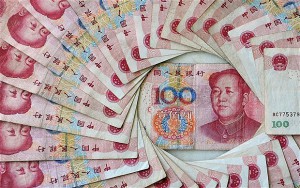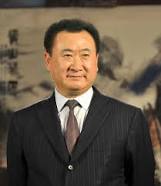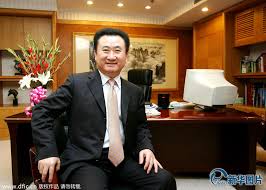|
|
|
| BEIJING, Aug. 19 (Xinhua) — The net inflows of foreign direct investment (FDI) into the financial institutions on the Chinese mainland were 4.138 billion U.S. dollars (25.327 billion yuan) in the second quarter of this year, official data showed on Wednesday. According to the State Administration of Foreign Exchange, FDI inflows into Chinese mainland’s financial sector, including banks, insurers, and securities firms, reached 4.432 billion U.S. dollars (RMB27.127 billion) in the second quarter of the year, while FDI outflows amounted to 294 million U.S. dollars (RMB1.8 billion) in the same time period. The statistics only cover equity investments that enable an investor to own 10 percent or more of voting stocks in a company. Enditem |
BEIJING, Aug. 19 (Xinhua) — Financial institutions on the Chinese mainland reported net outward direct investment (ODI) of 2.309 billion U.S. dollars (14.129 billion yuan) in the second quarter of the year, according to China’s top foreign-exchange regulator on Wednesday.
Data from the State Administration of Foreign Exchange showed that ODI outflows from Chinese mainland’s financial institutions, including banks, insurers, and securities firms, reached 6.146 billion U.S. dollars (37.615 billion yuan) in the second quarter of the year, while ODI inflows amounted to 3.837 billion U.S. dollars (23.486 billion yuan) in the same time period.
The calculations only cover equity investments that enable an investor to own 10 percent or more of voting stock in a company. Enditem
| China increases tax breaks for small businesses BEIJING, Aug. 19 (Xinhua) — The State Council, China’s cabinet, on Wednesday decided to extend tax breaks to more small businesses for their roles in generating jobs and growth. From Oct. 1, 2015 to the end of 2017, companies with annual taxable income under 300,000 yuan (46,900 U.S. dollars) will have their corporate tax halved, said a statement released after a meeting chaired by Premier Li Keqiang. Previously, the threshold was 200,000 yuan. The meeting also extended tax breaks for companies with a monthly revenue of 20,000 to 30,000 yuan from the end of 2015 to the end of 2017. They will be exempted from value-added tax and business tax. The move is the latest attempt to help small businesses, as they provide nearly 80 percent of urban jobs. In the first six months, about 2.39 million small and micro enterprises in China paid reduced taxes, savings them about 8.6 billion yuan, according to figures from the State Administration of Taxation. Enditem |
|
BEIJING, Aug. 19 (Xinhua) — China’s money market turnover soared 115.8 percent year on year to 52.2 trillion yuan in July, according to a monthly financial market report released by the Chinese central bank on Wednesday.
During the first seven months, the money market turnover amounted to 251.8 trillion yuan, registering a year-on-year increase of 84.7 percent.
Interbank weighted average offered rate rose 7 basis points (bp) from the preceding month to 1.51 percent and average pledged bond repo rate gained 2 bps month on month to 1.43 percent in July. Enditem
BEIJING, Aug. 19 (Greenpost) — Global investors are focusing more on renminbi assets in China, primarily to diversify asset allocation and seek higher returns amid the prospering economy, according to a report by Standard & Poor’s Ratings Services.

Ongoing improvements in self-governance and information transparency in the securitization market are likely to support the development of China’s capital market, according to “China securitization: linking international investors and renminbi assets”, released Tuesday by the leading rating agency.
“China’s securitization market is small compared with its bond market, but its evolution might indicate answers to some questions regarding China’s capital markets,” said Standard & Poor’s credit analyst Vera Chaplin.
Starting in late 2014, a number of infrastructure enhancements in China’s securitization market had raised issuance efficiency and promoted market self-governance, while narrowing information gaps, Chaplin noted.
For instance, the formal information disclosure requirements in China’s asset-backed securities (ABS) and residential mortgage-backed securities (RMBS) securitization, set out by China’s National Association of Financial Market Institutional Investors in May, enhanced transparency and enabled investors to better understand the performance of transactions.
The result has been an increase in interest from international investors, he said.
Participation of global investors are believed to benefit China’s capital markets. Apart from providing additional capital, a more international scheme will support funding diversity for issuers and promote market infrastructure construction to meet international standards.
“More than 140 billion yuan (21.9 billion U.S. dollars) in securitization transactions was issued under the two major securitization schemes in China in the first six months of 2015,” Chaplin said.
“The transactions reveal a standardized platform for asset collections and how to allocate assets’ economic value, the disclosure of more information so that risks could be analyzed, and the isolation of asset sellers’ credit risk,” Chaplin said.
“As a result, international investors now have an opportunity to reach economic sectors that in the past they could not because of the smaller scale of the issuers or difficulties involved in finding the value of the assets,” Enditem
Why Chinese currency has two names? Yuan and Renminbi. You can read more: http://www.bbc.com/news/10413076
BEIJING, Aug. 19 (Xinhua) — The Bank of China (BOC) Cross-border Renminbi (RMB) Index (CRI) increased 21 points month on month to 293 in June, according to the BOC on Wednesday.
The degree of activity in RMB cross-border transactions hit a record high in the month, and the degree of activity in RMB direct investment also witnessed year-on-year and month-on-month growth in June.
Meanwhile, the RMB under the current account saw a net inflow in June. Enditem
HANGZHOU, Aug. 19 (Greenpost) — Wang Jianlin, chairman of China’s property and entertainment giant Dalian Wanda Group, has overtaken Hong Kong’s Li Ka-shing to become the richest Chinese in the world, according to the new Hurun Rich List, reported Xinhua.

Wang’s wealth increased more than 50 percent year on year to 260 billion yuan (40.6 billion U.S. dollars) as of early June, Hurun Research Institute said in a press release on Wednesday.

Hong Kong tycoon Li Ka-shing, 87, was the second richest with a fortune of 200 billion yuan and Jack Ma, founder and chairman of Internet giant Alibaba, was named third richest with wealth of 165 billion yuan.
The list includes 1,577 tycoons from 18 countries and regions worth a minimum 2 billion yuan. Of those listed, 302 are from Kong Kong, Macao, Taiwan and foreign countries.
Their combined wealth was 12.7 trillion yuan, equalling the annual gross domestic product of Russia.

Rupert Hoogewerf, chair and chief Hurun Report researcher, said that Hurun had released this first rich for Chinese worldwide in response to global attention given to Chinese business people.
Hurun has released a China Rich List since 1999.
Wang Jianlin started with real estate. In 2001, at a real estate yearly meeting, he was there together with Feng Lun, Alex Xu and Liu Yonghao as keynote speaker. 14 years later, he became the first richest Chinese while the others still very rich, but mostly focusing on real estate.
Wang has been transforming his real estate into cinemas and entertainment site. He also collected a lot of world famous art works.
He thinks internet is just a tool while Jack Ma is using internet to make numerous shops. Let’s see what will happen in the next 14 or 15 years.
Wang was born in Oct. 24, 1954. He joined the Chinese army in 1970 and graduated from Liaoning University in 1986.
Wang’s success benefitted from China’s opening up policy and the support of governments at various levels. It was also his own and his team’s wisdom to understand the leader’s will and transform his group a couple of times according to the trend.
Source Xinhua
Editor Xuefei Chen Axelsson
The overarching objective of the strategy is for the UN climate change conference in Paris in 2015 to result in a global, fair and legally binding climate agreement that helps to keep global warming as far below two degrees as possible over time. The strategy rests on three pillars:
The effects of climate change affect all countries, but poor and vulnerable countries that do not have the resources to adapt to the changes are particularly hard hit. All countries must make the transition to a sustainable society with low emissions and high resilience to the effects of climate change. If done properly, a transition of this kind also has positive effects on economic development and poverty reduction, energy security and improved health, as well as important environmental targets such as clean air.
It is also important to take account of the challenges that come with such a transition. Sweden is encouraging a broader discussion on how the global investment flows can be aligned so that they support socially, economically and environmentally sustainable development with a considerably smaller prevalence of fossil fuels. Important global components include putting a price on carbon dioxide and not subsidising fossil energy.
A new climate agreement under the UN is crucial for international climate efforts. The agreement should be guided by science and include emissions commitments that, over time, can limit global warming to a level as far below two degrees as possible. This will require a higher level of climate ambition as well as new, enhanced initiatives in every country of the world and among central actors, including Sweden and the EU.
COP 21 can provide the political momentum to push forward a higher level of ambition concerning emission reductions also in the EU. Progress is needed regarding both emissions reductions and climate adaptation. Climate financing is important to strengthen climate action. Other tools and instruments for implementation, such as technology development, technology diffusion and capacity development, are also key to achieving the higher climate ambitions. Climate financing will be a crucial issue for whether the world can agree on a new climate agreement in Paris.
BEIJING, Aug. 12 (Xinhua) — Newly released economic indicators fell short of market expectations, revealing that the Chinese economy still lacks momentum and downward pressure remains.
China’s value-added industrial output, which measures the final value of industrial production, expanded 6 percent year on year in July, down from 6.8 percent for June, the National Bureau of Statistics (NBS) said Wednesday.
The decline in output growth ended a steady recovery trend recorded in the second quarter of this year.
NBS statistician Jiang Yuan attributed the drop mainly to flagging external demand, a weak property sector and lowered production of some consumer goods, including automobiles and cigarettes.
Year-on-year growth in the first seven months stood at 6.3 percent, the same level as the growth for the first half of the year.
The NBS data only tracks the output of large Chinese companies with annual primary business revenues of more than 20 million yuan (3.16 million U.S. dollars).
Industrial output in China’s western regions increased by 7.9 percent in July, trailed by 7.4 percent in central areas and 6 percent in eastern regions.
Manufacturing output rose 6.6 percent, mining output added 5.6 percent, while that of the electricity, heating, gas and water sectors dropped 0.2 percent, the bureau said.
China’s fixed-asset investment, a major driver of growth, also witnessed slightly slower growth, with no sign of improvement for investment in property and infrastructure.
Retail sales held steady in July, as the growth rate was just 0.1 percentage point lower than a month ago.
Qu Hongbin, chief China economist at HSBC, said the data fell below general market expectations.
The declining output and investment growth showed the rebound in June was just temporary and pressure for growth was again on the rise, Qu said.
“With gloomy prospects for external demand, China will still need to rely on domestic demand to maintain steady growth, indicating that future monetary and fiscal policies should continue to be relaxed,” he said.
China’s exports dropped 0.9 percent from a year earlier in the first seven months, according to new customs data.
A research note from Minsheng Securities also said China’s growth is still facing huge pressure and the country needs to make more efforts to realize its goal of annual economic growth of around 7 percent.
China should take more pragmatic measures to stabilize growth, including further cuts in the reserve requirement ratio (RRR) and more targeted measures to reduce long-term interest rates, Minsheng said.
Qu added that the disappointing figures will also reinforce the market’s expectations for further depreciation of China’s currency, the yuan, posing risks of overcorrection in the exchange rate, which may lead to retaliation from other countries.
On Tuesday, China’s central bank changed the exchange rate formation system to take into consideration the closing rate of the inter-bank foreign exchange market on the previous day, as well as supply and demand in the market and price movements of major currencies.
The central parity rate of the yuan weakened by about 1.6 percent against the U.S. dollar Wednesday, following a 2-percent depreciation on Tuesday.
HSBC forecast an additional 25-basis-point interest rate cut and a 200-basis-point cut to the RRR in the second half to sustain growth.
The central bank has cut both interest rates and the RRR three times since the beginning of this year. Enditem
Source Xinhua
BEIJING, Aug. 12 (Greenpost) — When China’s central bank unexpectedly adjusted its yuan central parity system, it triggered the currency’s biggest decline for decades.
So, what exactly happened?
On Tuesday, the People’s Bank of China (PBOC) changed the way it calculated the yuan central parity rate, to close the gap between the rate and the actual trading rate on the money markets.
From Tuesday, the central parity rate has taken into account the previous day’s inter-bank market closing rate, supply and demand in the market and price movements of other major currencies.
Ma Jun, a central bank economist, described the change to the way the central parity rate is calculated as a “one-off” technical correction that should not be seen as the beginning of a devaluation trend.
Just what is the central parity rate?
Each trading day at 9:15 a.m. Beijing time, the central parity rates of the yuan are announced against 11 major currencies including the euro, sterling, U.S. dollar and yen. The rates are determined by a weighted average of pre-opening prices offered by market makers. When the inter-bank FX market opens 15 minutes later, trading may only take place within 2 percent of the rate.
Why now?
The U.S. dollar is strong and a sharp appreciation in the real yuan rate has hit China’s exports hard. The figures for July slumped by 8 percent. Furthermore, the central parity rate has gradually deviated from the market rate “by a large amount and for a long duration,” according to the PBOC, which has undermined “the authority and the benchmark status” of the central parity system.
How did markets react?
On Wednesday, the yuan declined sharply for the second day in a row, leading to a heavy sell-off in regional currencies and raising concern worldwide that volatility will become a drag on global economic growth.
Asian stocks fell.
The yuan is expected to remain weak and volatile in the near term.
Is this a deliberate move to stimulate exports?
Tuesday’s move is regarded as another step towards allowing market forces to determine the value of the yuan, but is probably not enough to make much difference to either exporters or China’s trade partners.
HSBC say the move does not mean that China has begun to purposely devalue the yuan.
“In an environment of soft global recovery, the benefits of beggar-thy-neighbor competitive devaluation are neither clear nor easy to reap,” was the bank’s analysis of the situation.
How will this affect the Chinese people?
A weaker yuan makes imported products more expensive and foreign travel more costly.
The Chinese are just getting used to their new prosperity. Shopping has become very important to them, especially shopping for imported goods. Foreign travel for its own sake, but more specifically for shopping, is central to the aspirations of China’s new wealthy classes. Those who plan to study abroad, particularly at American schools, will also feel the pinch.
Is all this good or bad for the yuan’s chances of a quick inclusion in SDR?
The International Monetary Fund (IMF) has welcomed the reform, which will certainly raise the prospects for the yuan becoming part of the IMF special drawing rights (SDR) currency basket sooner rather than later.
The change does not directly affect the push for SDR inclusion, but an IMF spokesman said on Wednesday that “a more market-determined exchange rate would facilitate SDR operations in case the yuan was included in the currency basket.”
What’s the risk?
The depreciation might trigger capital flight, dealing a blow to the stability of China’s financial system. Bloomberg economists Fielding Chen and Tom Orlik reckon that a 1-percent depreciation against the dollar will suck 40 billion U.S. dollars out of China. While 40 billion U.S. dollars is certainly not chicken feed, with massive foreign exchange reserves, substantial bank deposits and a controlled capital account, China is well set to deal with such an eventuality.
So, what next?
The PBOC has promised more FX reform along the lines of “market- orientation” and opening up the FX market. More foreign entities are being allowed to participate in China’s financial markets, and the onshore-offshore yuan exchange rate will gradually be unified. Enditem
SHANGHAI, Aug. 12 (Greenpost) — China’s renminbi extended its sharp drop against the U.S. dollar on Wednesday from the previous day, but exporters say a weakened yuan has a limited effect on their business.
The official guidance rate of the Chinese currency shed 1.6 percent, or 1,008 basis points, on Wednesday, following Tuesday’s sharp fall of 1.9 percent.
Such a sharp decline against the greenback is unusual for the Chinese currency, which has been moving within a narrow range this year despite a firming dollar on expectations of the U.S. Federal Reserve’s rate hikes.
Analysts have largely attributed the correction in the exchange rate to China’s response to the IMF’s call for the currency to better reflect market forces, but the yuan’s weakening came on the heels of weak July export data. Yet exporters have shown a mixed response to the yuan’s drop in value.
“The depreciation does benefit Chinese exports, but to a limited effect.” said Liang Hong, chief economist at China International Capital Corporation.
Liang said that the depreciation that came as a result of tweaking the formation of the renminbi’s central parity rate will only marginally relieve the pressure on growth brought by slowing exports.
China’s July exports slid 8.3 percent from a year ago, far below the street consensus of -1.5 percent.
“The depreciation will boost confidence among exporters after the sluggish July export data,” said Lu Dong, deputy manager at the Shanghai branch of China Export & Credit Insurance Corp. “But that is not the purpose for the yuan’s slide and it won’t be the start of massive depreciation against the dollar.”
According to Julian Evans-Pritchard, China economist at Capital Economics, the change in how the reference rate is set is primarily intended as a move toward greater liberalization of the foreign exchange market ahead of the IMF’s decision about whether or not to include the renminbi in the SDR basket.
Though the yuan has depreciated significantly against the dollar, the drop in value is not as pronounced compared to other currencies.
Still, the yuan’s largest single day drop in almost two decades has some exporters cheering.
“Nothing makes me happier than seeing the yuan weaken against the dollar,” said Jiang Zhencheng, general manager of Shanghai Tianmao Stationary Co. Ltd.
“A strong yuan has blunted our competitiveness in the international market. The correction is such a relief for us as the United States is our key market,” Jiang said.
“The depreciation will benefit textiles and light industry as the two sectors in China are very export-oriented,” said CITIC analyst Ju Xinghai.
However, the actual positive impact of the depreciation is not as much as in theory because change in the exchange rate will lead to price adjustment, Ju added.
“The devaluation of the renminbi does work to our advantage. However, as a weaker yuan pushes up trade volume, our export price will also have to readjust,” said Li Qi, director of production at Licheng Clothing Group.
“Even if we don’t, our overseas clients will demand it anyway,” Li said. Enditem